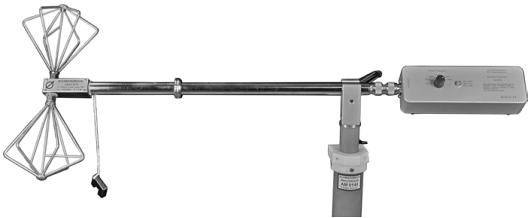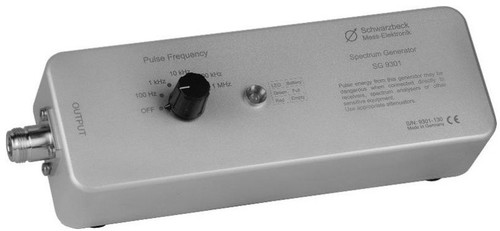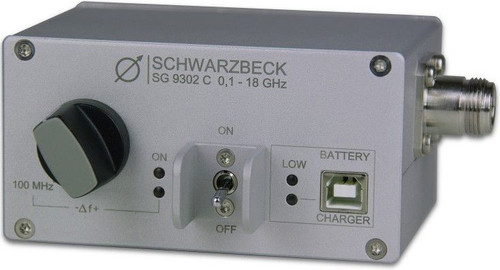Overview
The Spectrum Generator SG 9301 is a family member of the Schwarzbeck pulse generators, which are used as pulse standard world wide. Obviously there are some parallels to the IGUF 2910 S. Whilst the latter one uses a bounce free relay contact to discharge a coaxial line to the load resistor, the SG 9301 uses a special avalanche transistor instead of the relay contact.
Characteristics
- Small, powerful avalanche comb generator for operation without cables independent of position.
- Easy generation of calibration field strengths by direct connection to the antenna connector.
- Pulse frequencies 100 Hz, 1 kHz, 10 kHz, 100 kHz and 1 MHz to solve different measuring problems.
- CISPR 16-1-1 receiver test (F=30 MHz) using 100 Hz pulse frequency with 60 dBµV indication.
- Slow pulse frequency reveals even narrow band resonance due to a very "tight" spectrum. Fast pulse frequency for strong receiver level even with high site-attenuation.
The transistor cannot switch the very high voltages as the relay can, but on the other hand advantages like small outlines, position independent operation and the choice of five pulse frequencies make it very useful.
In contrast to usual generators for calibration field sources which produce a high number of harmonics by extreme driving of non-linear semiconductors at relatively low power supply voltage, the avalanche generator uses a coaxial line and a high, constant DC-voltage to determine pulse duration and pulse amplitude.
As a result of this principle the output spectrum is very constant and there is enough amplitude even at low pulse frequencies. Low pulse frequencies must be used when narrow spaced spectral lines are needed to recognise narrow band resonance or notches. The frequency spectrum can be measured precisely using an EMI receiver.
The result of this measurement combined with the antenna data can be used to calculate the field strength. An example how to calculate the field strength is given at the end of this manual. The built-in NiMH-battery keeps the generator working for about 10 hours and can be charged in a short time with the automatic charger ACS 110 traveller. A green LED shows readiness for operation.
To avoid wrong measurement caused by low battery voltage, the generator will be automatically disconnected from the battery before precision would suffer. The color of the LED would then change to red.
| Technical Data | |||||||||||||||||||||||||||||||||||||||||
| Pulse voltage across 50 Ohm load | ca. 24 V | ||||||||||||||||||||||||||||||||||||||||
| Pulse duration | ca. 0.75 ns | ||||||||||||||||||||||||||||||||||||||||
| Spectrum with pulse frequency 1 MHz, RMS value (typical) |
| ||||||||||||||||||||||||||||||||||||||||
| Indication on a CISPR 16-1-1, band C/D-receiver (Quasi-Peak), FR=30MHz, Pulse frequency 100 Hz | 60 dBµV | ||||||||||||||||||||||||||||||||||||||||
| Output | 50 ? N | ||||||||||||||||||||||||||||||||||||||||
| Dimensions milled housing only without connector, knob or feet WxHxD | 200x69x41 mm | ||||||||||||||||||||||||||||||||||||||||
| Overall Dimensions WxHxD | 222x69x67 mm | ||||||||||||||||||||||||||||||||||||||||
| Weight | ca. 0,77 kg | ||||||||||||||||||||||||||||||||||||||||
| Cabinet style | Milled aluminium body | ||||||||||||||||||||||||||||||||||||||||

Calculating example
Using te SG 9301 and the small biconical antenna UBAA 9114 with BBUK 9139 elements we want to generate a field (reference radiator). The free-space field strength at 30 MHz in a distance of 3 m is wanted. This can be calculated like this:
F [dBµV/m] = -2.2 + gi [dBi] + U [dBµV] - 20 log D [m]
Fieldstrength Level: F [dBµV/m]
gi [dBi]
Isotropic gain of the transmit antenna:
Voltage at antenna input under perfect matching conditions: U [dBµV]
Distance from the TX-antenna: D [m]
Using the voltage from the table above at 30 MHz and the gain of the antenna (from datasheet) of -38.24 dBi and the distance of 3 m we get: F = -2.2 -38.24 + 90.0 – 9.54
F = 40.02 dBµV/m
Biconical antennas usually have a very high VSWR in the lower frequency range. Conditions of perfect impedance matching are thus not applicable. Standing waves might cause measurement uncertainty. Forced impedance matching by using an attenuator like DGA 9552 N 10 dB between the SG 9301 and the antenna may be a way to eliminate standing waves. This works only if the generated field strengths show sufficient S/N.
The measured field strength should be at least 10 dB higher than the noise floor of the system. The distance to the noise floor can be improved by usiung a Tx antenna with a better gain, e.g. a larger biconical antenna like VHBB 9124 with BBA 9106 elements. Using this antenna instead of the small UBAA 9114 with BBUK 9139 will lead to 24 dB higher field strength levels.







